Bavaria
Free State of Bavaria
| |
|---|---|
| Anthem: Bayernhymne (German) "Hymn of Bavaria" | |
 | |
| Coordinates: 49°04′43″N 11°23′08″E / 49.07861°N 11.38556°E | |
| Country | Germany |
| Capital | Munich |
| Government | |
| • Body | Landtag of Bavaria |
| • Minister-President | Markus Söder (CSU) |
| • Governing parties | CSU / FW |
| • Bundesrat votes | 6 (of 69) |
| • Bundestag seats | 117 (of 736) |
| Area | |
| • Total | 70,550.19 km2 (27,239.58 sq mi) |
| Population (2022-12-31)[1] | |
| • Total | 13,369,393 |
| • Density | 189/km2 (490/sq mi) |
| Demonym | Bavarian |
| GDP | |
| • Total | €716.784 billion (2022) |
| • Per capita | €53,768 (2022) |
| Time zone | UTC+1 (CET) |
| • Summer (DST) | UTC+2 (CEST) |
| ISO 3166 code | DE-BY |
| NUTS Region | DE2 |
| HDI (2018) | 0.956[3] very high · 5th of 16 |
| Website | www |
Bavaria,[a] officially the Free State of Bavaria,[b] is a state in the southeast of Germany. With an area of 70,550.19 km2 (27,239.58 sq mi), it is the largest German state by land area, comprising roughly a fifth of the total land area of Germany. With over 13 million inhabitants, it is the second most populous German state behind North Rhine-Westphalia, but due to its large land area its population density is below the German average. Major cities include Munich (its capital and largest city, which is also the third largest city in Germany),[5] Nuremberg, and Augsburg.
The history of Bavaria includes its earliest settlement by Iron Age Celtic tribes, followed by the conquests of the Roman Empire in the 1st century BC, when the territory was incorporated into the provinces of Raetia and Noricum. It became the Duchy of Bavaria (a stem duchy) in the 6th century AD following the collapse of the Western Roman Empire. It was later incorporated into the Holy Roman Empire, became the independent Kingdom of Bavaria after 1806, joined the Prussian-led German Empire in 1871 while retaining its title of kingdom, and finally became a state of the Federal Republic of Germany in 1949.[6]
Bavaria has a distinct culture, largely because of its Catholic heritage and conservative traditions,[7] which includes a language, cuisine, architecture, festivals and elements of Alpine symbolism.[8] It also has the second-largest economy among the German states by GDP figures, giving it the status of a wealthy German region.[9]
Contemporary Bavaria also includes parts of the historical regions of Franconia and Swabia, in addition to Altbayern.
History[edit]
Antiquity[edit]
The Celts settled in the Bavarian Alps, also known as Celto-Slavs or Alpines, these peoples were famed, romanticized, and subjected to ancientness.[10]
Middle Ages[edit]
In the 530s, the Merovingian dynasty incorporated the kingdom of Thuringia after their defeat by the Franks. The Baiuvarii were Frankicised a century later.[11] The Lex Thuringorum documents an upper class nobility of adalingi.[12] From about 554 to 788, the house of Agilolfing ruled the Duchy of Bavaria, ending with Tassilo III who was deposed by Charlemagne.[13]
Tassilo I of Bavaria tried unsuccessfully to hold the eastern frontier against the expansion of Slavic peoples and the Pannonian Avars around 600. Garibald II seems to have achieved a balance of power between 610 and 616.[14]
At Hugbert's death in 735, the duchy passed to Odilo of Bavaria from the neighboring Alemannia. Odilo issued a Lex Baiuvariorum for Bavaria, completed the process of church organization in partnership with Saint Boniface in 739, and tried to intervene in Frankish succession disputes by fighting for the claims of the Carolingian dynasty. He was defeated near Augsburg in 743 but continued to rule until his death in 748.[15][16]
Saint Boniface completed the people's conversion to Christianity in the early 8th century. Tassilo III of Bavaria succeeded to rule Bavaria. He initially ruled under Frankish oversight but began to function independently from 763 onward. He was particularly noted for founding new monasteries and for expanding eastwards, oppressing Slavs in the eastern Alps and along the Danube and colonizing these lands. After 781, however, Charlemagne began to exert pressure and Tassilo III was deposed in 788. Dissenters attempted a coup against Charlemagne at Regensburg in 792, led by Pepin the Hunchback.
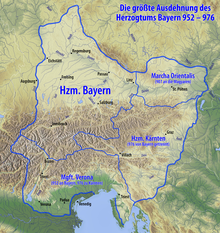
With the revolt of Henry II, Duke of Bavaria in 976, Bavaria lost large territories in the south and southeast.
One of the most important dukes of Bavaria was Henry the Lion of the house of Welf, founder of Munich, and de facto the second most powerful man in the empire as the ruler of two duchies. When in 1180, Henry the Lion was deposed as Duke of Saxony and Bavaria by his cousin, Frederick I, Holy Roman Emperor (a.k.a. "Barbarossa" for his red beard), Bavaria was awarded as fief to the Wittelsbach family, counts palatinate of Schyren ("Scheyern" in modern German). They ruled for 738 years, from 1180 to 1918. In 1180, however, Styria was also separated from Bavaria. The Electorate of the Palatinate by Rhine (Kurpfalz in German) was also acquired by the House of Wittelsbach in 1214, which they would subsequently hold for six centuries.[17]
The first of several divisions of the duchy of Bavaria occurred in 1255. With the extinction of the Hohenstaufen in 1268, Swabian territories were acquired by the Wittelsbach dukes. Emperor Louis the Bavarian acquired Brandenburg, Tyrol, Holland and Hainaut for his House but released the Upper Palatinate for the Palatinate branch of the Wittelsbach in 1329. That time also Salzburg finally became independent from the Duchy of Bavaria.
In the 14th and 15th centuries, upper and lower Bavaria were repeatedly subdivided. Four Duchies existed after the division of 1392: Bavaria-Straubing, Bavaria-Landshut, Bavaria-Ingolstadt and Bavaria-Munich. In 1506 with the Landshut War of Succession, the other parts of Bavaria were reunited, and Munich became the sole capital. The country became a center of the Jesuit-inspired Counter-Reformation.
Electorate of Bavaria[edit]
In 1623, the Bavarian duke replaced his relative of the Palatinate branch, the Electorate of the Palatinate in the early days of the Thirty Years' War and acquired the powerful prince-elector dignity in the Holy Roman Empire, determining its Emperor thence forward, as well as special legal status under the empire's laws. During the early and mid-18th century the ambitions of the Bavarian prince electors led to several wars with Austria as well as occupations by Austria (War of the Spanish Succession, War of the Austrian Succession with the election of a Wittelsbach emperor instead of a Habsburg).[citation needed]
To mark the unification of Bavaria and the Electoral Palatinate, both being principal Wittelsbach territories, Maximilian III Joseph, Elector of Bavaria was crowned king of Bavaria. King Maximilian III Joseph was quick to change the coat of arms. The various heraldic symbols were replaced and a classical Wittelsbach pattern introduced. The white and blue lozenges symbolized the unity of the territories within the Bavarian kingdom.[18]
The new state also comprised the Duchy of Jülich and Berg as these on their part were in personal union with the Palatinate.[citation needed]
Kingdom of Bavaria[edit]
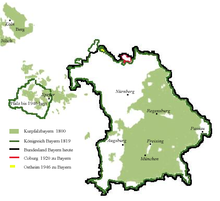
When the Holy Roman Empire dissolved under Napoleon's onslaught, Bavaria became a kingdom in 1806 and joined the Confederation of the Rhine.[19]
The Duchy of Jülich was ceded to France and the Electoral Palatinate was divided between France and the Grand Duchy of Baden. The Duchy of Berg was given to Joachim Murat. The County of Tyrol and the federal state of Salzburg were temporarily annexed with Bavaria but eventually ceded to Austria at the Congress of Vienna. In return, Bavaria was allowed to annex the modern-day region of Palatinate to the west of the Rhine and Franconia in 1815.
Between 1799 and 1817, the leading minister, Count Montgelas, followed a strict policy of modernization copying Napoleonic France; he laid the foundations of centralized administrative structures that survived the monarchy and, in part, have retained core validity through to the 21st century. In May 1808, a first constitution was passed by Maximilian I,[20] being modernized in 1818. This second version established a bicameral Parliament with a House of Lords (Kammer der Reichsräte) and a House of Commons (Kammer der Abgeordneten). That constitution was followed until the collapse of the monarchy at the end of World War I.
After the rise of Prussia in the early 18th century, Bavaria preserved its independence by playing off the rivalry of Prussia and Austria. Allied to Austria, it was defeated along with Austria in the 1866 Austro-Prussian War and was not incorporated into the North German Confederation of 1867, but the question of German unity was still alive. When France declared war on Prussia in 1870, all the south German states (Baden, Württemberg, Hessen-Darmstadt and Bavaria) aside from Austria, joined the Prussian forces and ultimately joined the Federation, which was renamed Deutsches Reich (German Empire) in 1871.
Bavaria continued as a monarchy, and retained some special rights within the federation (such as railways and postal services and control of its army in peace times).
Part of the German Empire[edit]
.svg/220px-Map-DR-Bavaria_(blau).svg.png)
When Bavaria became part of the newly formed German Empire, this action was considered controversial by Bavarian nationalists who had wanted to retain independence from the rest of Germany, as had Austria.
As Bavaria had a heavily Catholic majority population, many people resented being ruled by the mostly Protestant northerners in Prussia. As a direct result of the Bavarian-Prussian feud, political parties formed to encourage Bavaria to break away and regain its independence.[21]
In the early 20th century, Wassily Kandinsky, Paul Klee, Henrik Ibsen, and other artists were drawn to Bavaria, especially to the Schwabing district in Munich, a center of international artistic activity at the time.
Free State of Bavaria[edit]
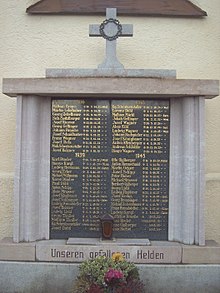
World War I led to the abolition of monarchy all over Germany in 1918. The Bavarian monarchy was the first to fall when on 8 November 1918 Socialist politician Kurt Eisner proclaimed the Free State (i.e. republic) of Bavaria. Eisner headed a new, republican government as minister-president. On 12 November, King Ludwig III signed the Anif declaration, releasing both civil and military officers from their oaths,[22] which the Eisner government interpreted as an abdication.[23]
After losing the January 1919 elections, Eisner was assassinated in February 1919, ultimately leading to a Communist revolt and the short-lived Bavarian Soviet Republic being proclaimed 6 April 1919. After violent suppression by elements of the German Army and notably the Freikorps, the Bavarian Soviet Republic fell in May 1919. The Bamberg Constitution (Bamberger Verfassung) was enacted on 12 or 14 August 1919 and came into force on 15 September 1919, placing Bavaria inside the Weimar Republic.
Extremist activity further increased, notably the 1923 Beer Hall Putsch led by the Nazis, and Munich and Nuremberg became seen as strongholds of Nazism during the Weimar Republic and Nazi dictatorship. However, in the crucial German federal election, March 1933, the Nazis received less than 50% of the votes cast in Bavaria.
As a manufacturing centre, Munich was heavily bombed during World War II and was occupied by United States Armed Forces, becoming a major part of the American Zone of Allied-occupied Germany, which lasted from 1945 to 1947, and then of Bizone.
The Rhenish Palatinate was detached from Bavaria in 1946 and made part of the new state Rhineland-Palatinate. In 1949, Bavaria became part of the Federal Republic of Germany, despite the Bavarian Parliament voting against adopting the Basic Law of Germany, mainly because it was seen as not granting sufficient powers to the individual states (Länder), but at the same time declared that it would accept it if two-thirds of the other Länder ratified it. All of the other states ratified it, so it became law.[24] Thus, during the Cold War, Bavaria was part of West Germany.
Bavarian identity[edit]
Bavarians have often emphasized a separate national identity and considered themselves as "Bavarians" first, "Germans" second.[25] In the 19th-century sense, an independent Kingdom of Bavaria existed from only 1806 to 1871. A separate Bavarian identity was emphasized more strongly when Bavaria joined the Prussia-dominated German Empire in 1871, while the Bavarian nationalists wanted to keep Bavaria as Catholic and an independent state. Aside from the minority Bavaria Party, most Bavarians now accept Bavaria as part of Germany.[26]
Another consideration is that Bavaria is not culturally uniform. While inhabitants Altbayern ("Old Bavaria"), the regions forming the historic Bavaria before further acquisitions in 1806-1815, speak a Bavarian dialect of German, Franconia in the north and Bavarian Swabia in the south west, have their unique culture, including different dialects of German, East Franconian and Swabian, respectively.
Flags and coat of arms[edit]
Flags[edit]
Uniquely among German states, Bavaria has two official flags of equal status, one with a white and blue stripe, the other with white and blue diamond-shaped lozenges. Either may be used by civilians and government offices, who are free to choose between them.[27] Unofficial versions of the flag, especially a lozenge style with coat of arms, are sometimes used by civilians.
Coat of arms[edit]
The modern coat of arms of Bavaria was designed by Eduard Ege in 1946, following heraldic traditions.
- The Golden Lion: At the dexter chief, sable, a lion rampant Or, armed and langued gules. This represents the administrative region of Upper Palatinate.
- The "Franconian Rake": At the sinister chief, per fess dancetty, gules, and argent. This represents the administrative regions of Upper, Middle and Lower Franconia.
- The Blue "Pantier" (mythical creature from French heraldry, sporting a flame instead of a tongue): At the dexter base, argent, a Pantier rampant azure, armed Or and langued gules. This represents the regions of Lower and Upper Bavaria.
- The Three Lions: At the sinister base, Or, three lions passant guardant sable, armed and langued gules. This represents Swabia.
- The White-And-Blue inescutcheon: The inescutcheon of white and blue fusils askance was originally the coat of arms of the Counts of Bogen, adopted in 1247 by the House of Wittelsbach. The white-and-blue fusils are indisputably the emblem of Bavaria and these arms today symbolize Bavaria as a whole. Along with the People's Crown, it is officially used as the Minor Coat of Arms.
- The People's Crown (Volkskrone): The coat of arms is surmounted by a crown with a golden band inset with precious stones and decorated with five ornamental leaves. This crown first appeared in the coat of arms to symbolize sovereignty of the people after the royal crown was eschewed in 1923.
Geography[edit]
.jpg/220px-Über_dem_Spitzsteinhaus_(3650068382).jpg)
Bavaria shares international borders with Austria (Salzburg, Tyrol, Upper Austria and Vorarlberg) and the Czech Republic (Karlovy Vary, Plzeň and South Bohemian Regions), as well as with Switzerland (across Lake Constance to the Canton of St. Gallen).
Neighboring states within Germany are Baden-Württemberg, Hesse, Thuringia, and Saxony. Two major rivers flow through the state: the Danube (Donau) and the Main. The Bavarian Forest and the Bohemian Forest form the vast majority of the frontier with the Czech Republic and Bohemia.
The geographic center of the European Union is located in the northwestern corner of Bavaria.
Climate[edit]
At lower elevations the climate is classified according to Köppen's guide as "Cfb" or "Dfb". At higher altitudes the climate becomes "Dfc" and "ET".
The summer months have been getting hotter in recent years.[28] For example, June 2019 was the warmest June in Bavaria since weather observations have been recorded[28] and the winter 2019/2020 was 3 degrees Celsius warmer than the average temperature for many years all over Bavaria. On 20 December 2019 a record temperature of 20.2 °C (68.4 °F) was recorded in Piding.[29] In general winter months are seeing more precipitation which is taking the form of rain more often than that of snow compared to the past.[28] Extreme weather like the 2013 European floods or the 2019 European heavy snowfalls is occurring more and more often. One effect of the continuing warming is the melting of almost all Bavarian Alpine glaciers: Of the five glaciers of Bavaria only the Höllentalferner is predicted to exist over a longer time perspective. The Südliche Schneeferner has almost vanished since the 1980s.[28]
Administrative divisions[edit]
Administrative regions[edit]
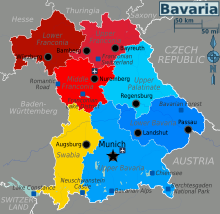
Bavaria is divided into seven administrative regions called Regierungsbezirke (singular Regierungsbezirk). Each of these regions has a state agency called the Bezirksregierung (district government).
- Altbayern:
- Upper Palatinate (German: Oberpfalz)
- Upper Bavaria (Oberbayern)
- Lower Bavaria (Niederbayern)
- Franconia:
- Upper Franconia (Oberfranken)
- Middle Franconia (Mittelfranken)
- Lower Franconia (Unterfranken)
- Swabia:
- Swabia (Schwaben)
Bezirke[edit]
Bezirke (regional districts) are the third communal layer in Bavaria; the others are the Landkreise and the Gemeinden or Städte. The Bezirke in Bavaria are territorially identical with the Regierungsbezirke, but they are self-governing regional corporation, having their own parliaments. In the other larger states of Germany, there are only Regierungsbezirke as administrative divisions and no self-governing entities at the level of the Regierungsbezirke as the Bezirke in Bavaria.
Population and area[edit]
| Bezirk | Coat of arms | Capital | Population (2019)[30] | Area (km2) | No. municipalities | |||
|---|---|---|---|---|---|---|---|---|
| Lower Bavaria | 
|
Landshut | 1,244,169 | 9.48% | 10,330 | 14.6% | 258 | 12.5% |
| Lower Franconia | 
|
Würzburg | 1,317,619 | 10.46% | 8,531 | 12.1% | 308 | 15.0% |
| Upper Franconia | 
|
Bayreuth | 1,065,371 | 8.49% | 7,231 | 10.2% | 214 | 10.4% |
| Middle Franconia | 
|
Ansbach | 1,775,169 | 13.65% | 7,245 | 10.3% | 210 | 10.2% |
| Upper Palatinate | 
|
Regensburg | 1,112,102 | 8.60% | 9,691 | 13.7% | 226 | 11.0% |
| Swabia | 
|
Augsburg | 1,899,442 | 14.21% | 9,992 | 14.2% | 340 | 16.5% |
| Upper Bavaria | 
|
Munich | 4,710,865 | 35.12% | 17,530 | 24.8% | 500 | 24.3% |
| Total | 13,124,737 | 100.0% | 70,549 | 100.0% | 2,056 | 100.0% | ||
Districts[edit]

The second communal layer is made up of 71 rural districts (called Landkreise, singular Landkreis) that are comparable to counties, as well as the 25 independent cities (Kreisfreie Städte, singular Kreisfreie Stadt), both of which share the same administrative responsibilities.
Rural districts:
Independent cities:
Municipalities[edit]

The 71 rural districts are on the lowest level divided into 2,031 regular municipalities (called Gemeinden, singular Gemeinde). Together with the 25 independent cities (kreisfreie Städte, which are in effect municipalities independent of Landkreis administrations), there are a total of 2,056 municipalities in Bavaria.
In 44 of the 71 rural districts, there are a total of 215 unincorporated areas (as of 1 January 2005, called gemeindefreie Gebiete, singular gemeindefreies Gebiet), not belonging to any municipality, all uninhabited, mostly forested areas, but also four lakes (Chiemsee-without islands, Starnberger See-without island Roseninsel, Ammersee, which are the three largest lakes of Bavaria, and Waginger See).
Major cities and towns[edit]
| City | Region | Inhabitants (2000) |
Inhabitants (2005) |
Inhabitants (2010) |
Inhabitants (2015) |
Change (%) |
|---|---|---|---|---|---|---|
| Munich | Upper Bavaria | 1,210,223 | 1,259,677 | 1,353,186 | 1,450,381 | +11.81 |
| Nuremberg | Middle Franconia | 488,400 | 499,237 | 505,664 | 509,975 | +3.53 |
| Augsburg | Swabia | 254,982 | 262,676 | 264,708 | 286,374 | +3.81 |
| Regensburg | Upper Palatinate | 125,676 | 129,859 | 135,520 | 145,465 | +7.83 |
| Ingolstadt | Upper Bavaria | 115,722 | 121,314 | 125,088 | 132,438 | +8.09 |
| Würzburg | Lower Franconia | 127,966 | 133,906 | 133,799 | 124,873 | +4.56 |
| Fürth | Middle Franconia | 110,477 | 113,422 | 114,628 | 124,171 | +3.76 |
| Erlangen | Middle Franconia | 100,778 | 103,197 | 105,629 | 108,336 | +4.81 |
| Bayreuth | Upper Franconia | 74,153 | 73,997 | 72,683 | 72,148 | −1.98 |
| Bamberg | Upper Franconia | 69,036 | 70,081 | 70,004 | 73,331 | +1.40 |
| Aschaffenburg | Lower Franconia | 67,592 | 68,642 | 68,678 | 68,986 | +1.61 |
| Landshut | Lower Bavaria | 58,746 | 61,368 | 63,258 | 69,211 | +7.68 |
| Kempten | Swabia | 61,389 | 61,360 | 62,060 | 66,947 | +1.09 |
| Rosenheim | Upper Bavaria | 58,908 | 60,226 | 61,299 | 61,844 | +4.06 |
| Neu-Ulm | Swabia | 50,188 | 51,410 | 53,504 | 57,237 | +6.61 |
| Schweinfurt | Lower Franconia | 54,325 | 54,273 | 53,415 | 51,969 | −1.68 |
| Passau | Lower Bavaria | 50,536 | 50,651 | 50,594 | 50,566 | +0.11 |
| Freising | Upper Bavaria | 40,890 | 42,854 | 45,223 | 46,963 | +10.60 |
| Straubing | Lower Bavaria | 44,014 | 44,633 | 44,450 | 46,806 | +0.99 |
| Dachau | Upper Bavaria | 38,398 | 39,922 | 42,954 | 46,705 | +11.87 |
Source: Bayerisches Landesamt für Statistik und Datenverarbeitung[31][32]
Politics[edit]

Bavaria has a multiparty system dominated by the conservative Christian Social Union (CSU), which has won every election since 1945 with the exception of the 1950 ballot. Other important parties are The Greens, which became the second biggest political party in the 2018 local parliament elections and the center-left Social Democrats (SPD), who have dominated the city of Munich until 2020. Hitherto, Wilhelm Hoegner has been the only SPD candidate to ever become Minister-President; notable successors in office include multi-term Federal Minister Franz Josef Strauss, a key figure among West German conservatives during the Cold War years, and Edmund Stoiber, who both failed with their bids for Chancellorship.
The German Greens and the center-right Free Voters have been represented in the state parliament since 1986 and 2008 respectively.
In the 2003 elections the CSU won a ⅔ supermajority – something no party had ever achieved in postwar Germany. However, in the subsequent 2008 elections the CSU lost the absolute majority for the first time in 46 years.[33]
The losses were partly attributed by some to the CSU's stance for an anti-smoking bill.[further explanation needed] (A first anti-smoking law had been proposed by the CSU and passed but was watered down after the election, after which a referendum enforced a strict antismoking bill with a large majority).
Current Landtag[edit]

The last state elections were held on 8 October 2023. The CSU could almost maintain the results from the last elections with 37%. The Greens lost 3% compared to the last election with a result of 14.4%. The SPD lost again compared to the last election and was now at 8.4%. The liberals of the FDP were not able to reach the five-percent-threshold thus they are not part of the Landtag anymore, the second time after the 2013 elections. The right-wing populist Alternative for Germany (AfD) gained another 4% with now at 14.6% of the vote.[34]
The center-right Free Voters party gained 15.8% of the votes and for the second time formed a government coalition with the CSU which led to the subsequent reelection of Markus Söder as Minister-President of Bavaria.[35]
Government[edit]
The Constitution of Bavaria of the Free State of Bavaria was enacted on 8 December 1946. The new Bavarian Constitution became the basis for the Bavarian State after the Second World War.
Bavaria has a unicameral Landtag (English: State Parliament), elected by universal suffrage.[36] Until December 1999, there was also a Senat, or Senate, whose members were chosen by social and economic groups in Bavaria, but following a referendum in 1998, this institution was abolished.[37]
The Bavarian State Government consists of the Minister-President of Bavaria, eleven Ministers and six Secretaries of State. The Minister-President is elected for a period of five years by the State Parliament and is head of state. With the approval of the State Parliament he appoints the members of the State Government. The State Government is composed of the:
- State Chancellery (Staatskanzlei)
- Ministry of the Interior, for Sport and Integration (Staatsministerium des Innern, für Sport und Integration)
- Ministry for Housing, Construction and Transport (Staatsministerium für Wohnen, Bau und Verkehr)
- Ministry of Justice (Staatsministerium der Justiz)
- Ministry for Education and Culture (Staatsministerium für Bildung und Kultus)
- Ministry for Science and Art (Staatsministerium für Wissenschaft und Kunst)
- Ministry of Finance and for Home Affairs (Staatsministerium der Finanzen und für Heimat)
- Ministry for Economic Affairs, Regional Development and Energy (Staatsministerium für Wirtschaft, Landesentwicklung und Energie)
- Ministry for Environment and Consumer Protection (Staatsministerium für Umwelt und Verbraucherschutz)
- Ministry for Food, Agriculture and Forestry (Staatsministerium für Ernährung, Landwirtschaft und Forsten)
- Ministry for Family, Labour and Social Affairs (Staatsministerium für Familie, Arbeit und Soziales)
- Ministry for Health and Care (Staatsministerium für Gesundheit und Pflege)
- Ministry for Digital Affairs (Staatsministerium für Digitales)[38]
Political processes also take place in the seven regions (Regierungsbezirke or Bezirke) in Bavaria, in the 71 rural districts (Landkreise) and the 25 towns and cities forming their own districts (kreisfreie Städte), and in the 2,031 local authorities (Gemeinden).
In 1995 Bavaria introduced direct democracy on the local level in a referendum. This was initiated bottom-up by an association called Mehr Demokratie (English: More Democracy). This is a grass-roots organization which campaigns for the right to citizen-initiated referendums. In 1997 the Bavarian Supreme Court tightened the regulations considerably (including by introducing a turn-out quorum). Nevertheless, Bavaria has the most advanced regulations on local direct democracy in Germany. This has led to a spirited citizens' participation in communal and municipal affairs—835 referendums took place from 1995 through 2005.
Minister-presidents of Bavaria since 1945[edit]

| Ministers-President of Bavaria | |||||
|---|---|---|---|---|---|
| No. | Name | Born and died | Party affiliation | Begin of tenure | End of tenure |
| 1 | Fritz Schäffer | 1888–1967 | CSU | 1945 | 1945 |
| 2 | Wilhelm Hoegner | 1887–1980 | SPD | 1945 | 1946 |
| 3 | Hans Ehard | 1887–1980 | CSU | 1946 | 1954 |
| 4 | Wilhelm Hoegner | 1887–1980 | SPD | 1954 | 1957 |
| 5 | Hanns Seidel | 1901–1961 | CSU | 1957 | 1960 |
| 6 | Hans Ehard | 1887–1980 | CSU | 1960 | 1962 |
| 7 | Alfons Goppel | 1905–1991 | CSU | 1962 | 1978 |
| 8 | Franz Josef Strauß | 1915–1988 | CSU | 1978 | 1988 |
| 9 | Max Streibl | 1932–1998 | CSU | 1988 | 1993 |
| 10 | Edmund Stoiber | *1941 | CSU | 1993 | 2007 |
| 11 | Günther Beckstein | *1943 | CSU | 2007 | 2008 |
| 12 | Horst Seehofer | *1949 | CSU | 2008 | 2018 |
| 13 | Markus Söder | *1967 | CSU | 2018 | Incumbent |
Designation as a "free state"[edit]
Unlike most German states (Länder), which simply designate themselves as "State of" (Land [...]), Bavaria uses the style of "Free State of Bavaria" (Freistaat Bayern). The difference from other states is purely terminological, as German constitutional law does not draw a distinction between "States" and "Free States". The situation is thus analogous to the United States, where some states use the style "Commonwealth" rather than "State". The term "Free State", a creation of the 19th century and intended to be a German alternative to (or translation of) the Latin-derived republic, was common among the states of the Weimar Republic, after German monarchies had been abolished. Unlike most other states – many of which were new creations – Bavaria has resumed this terminology after World War II. Two other states, Saxony and Thuringia, also call themselves "Free State".
Arbitrary arrest and human rights[edit]
In July 2017, Bavaria's parliament enacted a new revision of the "Gefährdergesetz", allowing the authorities to imprison a person for a three months term, renewable indefinitely, when they have not committed a crime but it is assumed that they might commit a crime "in the near future".[39] Critics like the prominent journalist Heribert Prantl have called the law "shameful" and compared it to Guantanamo Bay detention camp,[40] assessed it to be in violation of the European Convention on Human Rights,[41] and also compared it to the legal situation in Russia, where a similar law allows for imprisonment for a maximum term of two years (i.e., not indefinitely).[42]
Economy[edit]


Bavaria has long had one of the largest economies of any region in Germany, and in Europe.[43] Its gross domestic product (GDP) in 2007 exceeded €434 billion (about U.S. $600 billion).[44] This makes Bavaria itself one of the largest economies in Europe, and only 20 countries in the world have a higher GDP.[45] The GDP of the region increased to €617.1 billion in 2018, accounting for 18.5% of German economic output. GDP per capita adjusted for purchasing power was €43,500 or 145% of the EU27 average in the same year. The GDP per employee was 114% of the EU average. This makes Bavaria one of the wealthiest regions in Europe.[46] Bavaria has strong economic ties with Austria, Czech Republic, Switzerland, and Northern Italy.[47] In 2019 GDP was €832.4 ($905.7) billion, €48,323 ($52,577.3) per capita.[48]
Agriculture[edit]
The most distinctive high points of Bavarian agriculture are:
- Hop growing in region Hallertau, which is up to 80% of German production and exported worldwide.
- Inland aquaculture of carps and trout.
- The well-hydrated alpine meadows are used to produce large quantities of quality milk, which is used to make a variety of cheese (including blue-veined cheese), yogurt and butter.
- The cultivation of asparagus is widespread, which is a very popular new season vegetable. In season ("Spargelzeit") restaurants offer special separated asparagus menu. There is an asparagus museum in Schrobenhausen.
- There are farms producing venison from deer and roe.
- Viticulture is widespread in Lower Franconia.
- Good ecology and strict control allow produce a large amount of organic products ("bio") and baby food.
-
Hopfengarten (hop garden)
-
Allgäuer meadows
-
Asparagus with sauce hollandaise
-
Vineyards in Klingenberg-am-Main
Industries[edit]
Bavaria has the best developed industry in Germany[49] and the lowest unemployment rate with 2.9% as of October 2021.[50]
Branches:
- Oil refining. Although there is oil production in Bavaria, it does not meet domestic needs. Most of the oil is imported via pipelines from the Czech Republic (Russian oil) and from the Italian port of Trieste (Near East oil). Three refineries are situated near Ingolstadt and another one in Burghausen. Last one is a part of Bavarian chemical triangle and delivery raw materials to other chemical plants.
-
Refinery Ingolstadt
-
Transalpine pipeline
- Automotive is the most important and best developed Bavarian industry, which includes manufacture of luxury cars (4 BMW and 2 Audi plants, R&D centers, test tracks), trucks (Traton MAN), special vehicles (Tadano Faun), buses (Evobus/Setra) and automotive parts (engines, electronics, cables, seats, interiors, cabrio roofs, heating and brake systems, software). Bavaria has the second-most employees (207,829) in the automotive industry of all German states after Baden-Württemberg as of 2018.[51]
-
BMW 7 Series
-
Audi A5
-
MAN TGX
-
Faun HK 100
-
Setra S515HDH
- Aerospace and defense, which manufacture multi-role attack jet Eurofighter Typhoon, missiles from MBDA and Diehl Defence, parts of rocket Ariane, regional jet Dornier 728, ultra-light planes from Grob Aerospace, turbo jet engines for civil and military applications from MTU Aero Engines, helicopters Airbus, main battle tank Leopard 2, drones, composite parts, avionics, radars, propellants, initiators, powder, munitions. In Munich suburban Oberpfaffenhofen situated control center of European satellite navigation system Galileo, German Space Operations Center, Microwaves and Radar Institute, Institute of Communications and Navigation, Remote Sensing Technology Institute, Institute of Atmospheric Physics, Institute of Robotics and Mechatronics, Institute for Software Technology, Institute of System Dynamics and Control.
-
Eurofighter Typhoon
-
Grob G 120TP
-
Airbus EC-665 Tiger
-
PARS 3 LR
-
Leopard 2
- Other transport manufacturing are represented in Bavaria. Ship yards even exist, for example Bavaria Yachtbau, despite being located many hundreds of kilometers from the sea, manufacturing 4-stroke marine diesel engines which are used in cruise liners, ferries and warships. Rail technology is produced in Munich-Allach (locomotive Siemens Vectron) and rail maintenance vehicles in Freilassing.
-
Bavaria R40
-
MAN marine diesel
-
Siemens Vectron
-
Robel BR 711.2
- Electronics. Chip design centers situated in Munich area (Infineon, Intel, Apple). There are 3 FABs: Infineon in Regensburg, Texas Instruments in Freising and Osram Optosemiconductors also in Regensburg. Power semiconductors are manufactured by Semikron. CNC controls are produced by Heidenhain, Traunreut and Siemens, Amberg. Silicon wafer for electronic manufacturing are delivered from Siltronic plant in Burghausen.
-
Campeon - Infineon and Intel R&D centers
-
CNC controls Heidehain iTNC 530
-
Programmable logic controller Siemens Simatic S7-1500
-
Silicon wafers
- Medical equipment. In Erlangen is a headquarters of Siemens Healthineers which produce devices for computer tomography, interventional X-ray systems, radiation therapy, molecular and magnetic resonance imaging, software. Brainlab creates software and hardware for image-guided surgery. Roche Diagnostics in Penzberg manufactures therapeutic proteins, diagnostic tests, reagents, analyze system and biopharma products.
-
Siemens E.Cam Duet
- Brewery. Bavaria has long tradition of brewery, near a half of all German breweries are located here (645 of 1300). All possible types of breweries exist: home brewery of hotel or restaurant, belong to big international concern, state-owned, castle or monastery breweries. The perfect quality of beer is guaranteed by 500-years law ("Reinheitsgebot"), which allow as beer ingredients only water, hops, yeast and malt of barley, wheat or rye. But difference of roasting, fermentation or mixing allow to produce many different types of beers (not brand). Vladimir Putin at 2009 tasted beer from Brauerei Aying, Barack Obama at 2015 also tasted Bavarian beer of Karg Brauerei in Murnau. In Freising situated research center Weihenstephan for brewing and food quality.
-
Brauerei Aying
-
Murnau am Staffelsee
-
Cold reservoirs
-
Tanks
Companies[edit]
Many large companies are headquartered in Bavaria, including Adidas, Allianz, Audi, BMW, Brose, BSH Hausgeräte, HypoVereinsbank, Infineon, KUKA, Traton, MTU Aero Engines, Munich Re, Osram, Puma, Rohde & Schwarz, Schaeffler, Siemens, Wacker Chemie, Linde, Vitesco Technologies, Webasto, Grob, Heidenhain, Koenig & Bauer, Kaeser Compressors, Krones, Knorr-Bremse, Wacker Neuson, Krauss-Maffei Wegmann, Siltronic, Leoni, Fielmann, MediaMarkt, Conrad Electronic, BayWa, ProSiebenSat.1 Media, Telefónica Germany, Knauf, Rehau, and Giesecke+Devrient.
Several American companies have established research and development facilities in the Munich region: Apple (chip design), Google (data security), IBM (Watson technology), Intel (drones and telecommunication chips), General Electric (3D-printers and additive manufacturing), Gleason (gears manufacturing), Texas Instruments (chip design and manufacturing), Coherent (lasers).
Tourism[edit]
With 40 million tourists in 2019, Bavaria is the most visited German state and one of Europe's leading tourist destinations.[52]
Attractions include:
- Amusement parks: Legoland in Günzburg, Bayern-Park in Reisbach (Vils), Playmobil in Zirndorf, Skyline Park in Bad Wörishofen and Bavaria Filmstadt in Grünwald
- Christmas markets in Rothenburg ob der Tauber, Nuremberg and Munich
- Factory Outlet Centers: Ingolstadt Village and Wertheim Village
- Festivals: Oktoberfest, Nürnberger Frühlingsfest and Nürnberger Herbstfest
- Museums and castles: Deutsches Museum, Alte Pinakothek, Lenbachhaus, Bavarian National Museum in Munich, Germanisches Nationalmuseum in Nuremberg, Margravial Opera House in Bayreuth, Maximilianmuseum Augsburg
-
Schloss Ehrenburg in Coburg
-
Hofer Theresienstein
-
Nürnberger Kaiserburg
-
Steinerne Brücke and Dom in Regensburg
-
Walhalla, Donaustauf near Regensburg
-
Befreiungshalle, Kelheim
-
St. Bartholomä Church at Lake Königssee
-
Hintersee in Ramsau bei Berchtesgaden
-
Preserved blast furnace 3 of Maxhütte in Sulzbach-Rosenberg
-
Stadtbrille Amberg
-
St. Martin Church (Landshut)
-
Dom St. Stephan in Passau
-
Congress hall with Doku-Zentrum in Nürnberg
-
Marienplatz, Munich
Unemployment[edit]
The unemployment rate stood at 2.6% in October 2018, the lowest in Germany and one of the lowest in the European Union.[53]
| Year[54] | 2000 | 2001 | 2002 | 2003 | 2004 | 2005 | 2006 | 2007 | 2008 | 2009 | 2010 | 2011 | 2012 | 2013 | 2014 | 2015 | 2016 | 2017 | 2018 | 2019 | 2020 | 2021 |
|---|---|---|---|---|---|---|---|---|---|---|---|---|---|---|---|---|---|---|---|---|---|---|
| Unemployment rate in % | 5.5 | 5.3 | 6.0 | 6.9 | 6.9 | 7.8 | 6.8 | 5.3 | 4.2 | 4.8 | 4.5 | 3.8 | 3.7 | 3.8 | 3.8 | 3.6 | 3.5 | 3.2 | 2.9 | 2.8 | 3.6 | 3.5 |
Demographics[edit]

Bavaria has a population of approximately 13.1 million inhabitants (2020). Eight of the 80 largest cities in Germany are located within Bavaria with Munich being the largest (1,484,226 inhabitants, approximately 6.1 million when including the broader metropolitan area), followed by Nuremberg (518,370 inhabitants, approximately 3.6 million when including the broader metropolitan area), Augsburg (296,582 inhabitants) and Regensburg (153,094 inhabitants). All other cities in Bavaria had less than 150,000 inhabitants each in 2020. Population density in Bavaria was 186/km2 (480/sq mi), below the national average of 233/km2 (600/sq mi). Foreign nationals resident in Bavaria (both immigrants and refugees/asylum seekers) were principally from other EU countries and Turkey.
| Nationality | Population (31 December 2022) | Population (31 December 2023) | |
|---|---|---|---|
| 1 | 209,810 | 213,770 | |
| 2 | 194,730 | 204,260 | |
| 3 | 178,925 | 181,880 | |
| 4 | 133,090 | 133,425 | |
| 5 | 119,320 | 120,100 | |
| 6 | 107,930 | 108,230 | |
| 7 | 85,445 | 92,405 | |
| 8 | 90,050 | 84,210 | |
| 9 | 76,705 | 79,365 | |
| 10 | 78,875 | 76,155 |
Vital statistics[edit]
| Comparison period | Births | Deaths | Natural growth |
|---|---|---|---|
| January – November 2016 | |||
| January – November 2017 |
Culture[edit]
Some features of the Bavarian culture and mentality are remarkably distinct from the rest of Germany. Noteworthy differences (especially in rural areas, less significant in the major cities) can be found with respect to religion, traditions, and language.
Religion[edit]

Bavarian culture (Altbayern) has a long and predominant tradition of Roman Catholic faith. Pope Benedict XVI (Joseph Alois Ratzinger) was born in Marktl am Inn in Upper Bavaria and was Cardinal-Archbishop of Munich and Freising. Otherwise, the culturally Franconian and Swabian regions of the modern State of Bavaria are historically more diverse in religiosity, with both Catholic and Protestant traditions. In 1925, 70.0% of the Bavarian population was Catholic, 28.8% was Protestant, 0.7% was Jewish, and 0.5% was placed in other religious categories.[58]
As of 2020[update] 46.9% of Bavarians adhered to Catholicism (a decline from 70.4% in 1970).[59][57] 17.2 percent of the population adheres to the Evangelical Lutheran Church in Bavaria, which has also declined since 1970.[59][57] Three percent was Orthodox, Muslims make up 4.0% of the population of Bavaria. 31.9 percent of Bavarians are irreligious or adhere to other religions.
Traditions[edit]
Bavarians commonly emphasize pride in their traditions. Traditional costumes collectively known as Tracht are worn on special occasions and include in Altbayern Lederhosen for males and Dirndl for females. Centuries-old folk music is performed. The Maibaum, or Maypole (which in the Middle Ages served as the community's business directory, as figures on the pole represented the trades of the village), and the bagpipes of the Upper Palatinate region bear witness to the ancient Celtic and Germanic remnants of cultural heritage of the region. There are many traditional Bavarian sports disciplines, e.g. the Aperschnalzen, competitive whipcracking.
Whether in Bavaria, overseas or with citizens from other nations Bavarians continue to cultivate their traditions. They hold festivals and dances to keep their heritage alive.
Food and drink[edit]
Bavarians tend to place a great value on food and drink. In addition to their renowned dishes, Bavarians also consume many items of food and drink which are unusual elsewhere in Germany; for example Weißwurst ("white sausage") or in some instances a variety of entrails. At folk festivals and in many beer gardens, beer is traditionally served by the litre (in a Maß). Bavarians are particularly proud[60] of the traditional Reinheitsgebot, or beer purity law, initially established by the Duke of Bavaria for the City of Munich (i.e. the court) in 1487 and the duchy in 1516. According to this law, only three ingredients were allowed in beer: water, barley, and hops. In 1906 the Reinheitsgebot made its way to all-German law, and remained a law in Germany until the EU partly struck it down in 1987 as incompatible with the European common market.[61] German breweries, however, cling to the principle, and Bavarian breweries still comply with it in order to distinguish their beer brands.[62] Bavarians are also known as some of the world's most prolific beer drinkers, with an average annual consumption of 170 liters per person.[citation needed]
Bavaria is also home to the Franconia wine region, which is situated along the river Main in Franconia. The region has produced wine (Frankenwein) for over 1,000 years and is famous for its use of the Bocksbeutel wine bottle. The production of wine forms an integral part of the regional culture, and many of its villages and cities hold their own wine festivals (Weinfeste) throughout the year.
-
Schweinsbraten
-
Nürnberger Rostbratwürste
Language and dialects[edit]
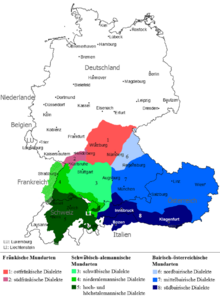
Three German dialects are most commonly spoken in Bavaria: Austro-Bavarian in Old Bavaria (Upper Bavaria, Lower Bavaria, and the Upper Palatinate), Swabian German (an Alemannic German dialect) in the Bavarian part of Swabia (southwest) and East Franconian German in Franconia (north). In the small town Ludwigsstadt in the north, district Kronach in Upper Franconia, Thuringian dialect is spoken. During the 20th century an increasing part of the population began to speak Standard German (Hochdeutsch), mainly in the cities.
Ethnography[edit]
Bavarians consider themselves to be egalitarian and informal.[63] Their sociability can be experienced at the annual Oktoberfest, the world's largest beer festival, which welcomes around six million visitors every year, or in the famous beer gardens. In traditional Bavarian beer gardens, patrons may bring their own food but buy beer only from the brewery that runs the beer garden.[64]
Museums[edit]
There are around 1,300 museums in Bavaria, including museums of art and cultural history, castles and palaces, archaeological and natural history collections, museums of technological and industrial history, and farm and open-air museums. The history of Bavarian museums dates back to manorial cabinets of curiosities and treasuries. The art holdings of the House of Wittelsbach thus formed the first and essential foundation of later state museums. As early as the mid-16th century, Duke Albrecht V (r. 1550–1579) had collected paintings as well as Greek and Roman sculptures (or copies made of them). He had the Antiquarium in the Munich Residence built specifically for his collection of antique sculptures. The electors Maximilian I (r. 1594–1651) and Max II. Emanuel (r. 1679–1726) expanded the art collections considerably. In the Age of Enlightenment at the end of the 18th century, there was a demand to open up art collections to the general public in the spirit of "popular education". But Museums were not founded by the state until the time of the art-loving King Ludwig I (r. 1825–1848). In Munich, he built Glyptothek (opened 1830), Alte Pinakothek (opened 1836), and Neue Pinakothek (opened 1853). Also, the foundation of the Germanisches Nationalmuseum in Nuremberg (1852), the establishment of the Neue Pinakothek, which opened in 1853, and the Bavarian National Museum (1867) in Munich were of central importance for the development of museums in Bavaria in the 19th century. With the end of the monarchy in 1918, many castles and formerly Wittelsbach property passed to the young Free State. In particular, the castles of king Ludwig II (r. 1864–1886) Neuschwanstein, Linderhof and Herrenchiemsee, quickly became magnets for the public. Since then, the number of Bavarian Museums has grown considerably, from 125 in 1907 to around 1,300 today.[65]
Sports[edit]
Football[edit]
Bavaria is home to several football clubs including FC Bayern Munich, 1. FC Nürnberg, FC Augsburg, TSV 1860 Munich, FC Ingolstadt 04 and SpVgg Greuther Fürth. Bayern Munich is the most successful football team in Germany having won a record 32 German titles and 6 UEFA Champions League titles. They are followed by 1. FC Nürnberg who have won 9 titles. SpVgg Greuther Fürth have won 3 championships while TSV 1860 Munich have been champions once.
Basketball[edit]
Bavaria is also home to four professional basketball teams, including FC Bayern Munich, Brose Baskets Bamberg, s.Oliver Würzburg, Nürnberg Falcons BC, and TSV Oberhaching Tropics.
Ice hockey[edit]
There are five Bavarian ice hockey teams playing in the German top-tier league DEL: EHC Red Bull München, Nürnberg Ice Tigers, Augsburger Panther, ERC Ingolstadt, and Straubing Tigers.
Notable people[edit]
Notable people who have lived, or live currently, in Bavaria include:
- Kings: Arnulf of Carinthia, Carloman of Bavaria, Charles the Fat, Lothair I, Louis the Child, Louis the German, Louis the Younger, Ludwig I of Bavaria, Ludwig II of Bavaria, Ludwig III of Bavaria, Maximilian I Joseph of Bavaria, Maximilian II of Bavaria, Otto, King of Bavaria
- Religious leaders: Pope Benedict XVI (Joseph Aloisius Ratzinger); Pope Damasus II, Pope Victor II
- Painters: Albrecht Dürer, Albrecht Altdorfer, Joseph Karl Stieler, Carl Spitzweg, Erwin Eisch, Franz von Lenbach, Franz von Stuck, Franz Marc, Gabriele Münter, Hans Holbein the Elder, Johann Christian Reinhart, Lucas Cranach, Paul Klee
- Classical musicians: Orlando di Lasso, Christoph Willibald Gluck, Leopold Mozart, Max Reger, Richard Wagner, Richard Strauss, Carl Orff, Johann Pachelbel, Theobald Boehm, Klaus Nomi
- Other musicians: Hans-Jürgen Buchner, Barbara Dennerlein, Klaus Doldinger, Franzl Lang, Bands: Spider Murphy Gang, Sportfreunde Stiller, Obscura, Michael Bredl
- Opera singers: Jonas Kaufmann, Diana Damrau
- Writers, poets and playwrights: Hans Sachs, Jean Paul, Friedrich Rückert, August von Platen-Hallermünde, Frank Wedekind, Christian Morgenstern, Oskar Maria Graf, Bertolt Brecht, Lion Feuchtwanger, Thomas Mann, Klaus Mann, Golo Mann, Ludwig Thoma, Michael Ende, Ludwig Aurbacher
- Scientists: Max Planck, Wilhelm Conrad Röntgen, Werner Heisenberg, Adam Ries, Joseph von Fraunhofer, Georg Ohm, Johannes Stark, Carl von Linde, Ludwig Prandtl, Rudolf Mössbauer, Lothar Rohde, Hermann Schwarz, Robert Huber, Martin Behaim, Levi Strauss, Rudolf Diesel, Feodor Lynen, Georges J. F. Köhler, Erwin Neher, Ernst Otto Fischer, Johann Deisenhofer
- Physicians: Alois Alzheimer, Max Joseph von Pettenkofer, Sebastian Kneipp
- Politicians: Ludwig Erhard, Horst Seehofer, Christian Ude, Kurt Eisner, Franz-Josef Strauß, Roman Herzog, Leonard John Rose, Henry Kissinger
- Football players: Max Morlock, Karl Mai, Franz Beckenbauer, Sepp Maier, Gerd Müller, Paul Breitner, Bernd Schuster, Klaus Augenthaler, Lothar Matthäus, Philipp Lahm, Bastian Schweinsteiger, Holger Badstuber, Thomas Müller, Mario Götze, Dietmar Hamann, Stefan Reuter
- Other sportspeople: Bernhard Langer, Dirk Nowitzki, Phoenix Sanders
- Actors: Michael Herbig, Werner Stocker, Helmut Fischer, Walter Sedlmayr, Gustl Bayrhammer, Ottfried Fischer, Ruth Drexel, Elmar Wepper, Fritz Wepper, Uschi Glas, Yank Azman
- Entertainers: Siegfried Fischbacher, Thomas Gottschalk
- Film directors: Helmut Dietl, Rainer Werner Fassbinder, Bernd Eichinger, Joseph Vilsmaier, Hans Steinhoff, Werner Herzog
- Designers: Peter Schreyer, Damir Doma, Thomas Nast
- Entrepreneurs: Charles Diebold, Adi Dassler, Rudolf Dassler, Levi Strauss, Ed Meier
- Military: Claus von Stauffenberg
- Nazis: Sepp Dietrich, Karl Fiehler, Karl Gebhardt, Hermann Göring, Heinrich Himmler, Alfred Jodl, Josef Kollmer, Josef Mengele, Ernst Röhm, Franz Ritter von Epp, Julius Streicher
- Others: Kaspar Hauser, The Smith of Kochel, Mathias Kneißl, Matthias Klostermayr, Anneliese Michel, Herluka von Bernried
See also[edit]
- Outline of Germany
- Former countries in Europe after 1815
- List of Bavaria-related topics
- List of ministers-president of Bavaria
- List of rulers of Bavaria
Notes[edit]
- ^ /bəˈvɛəriə/ bə-VAIR-ee-ə; German: Bayern [ˈbaɪɐn]
- ^ German: Freistaat Bayern[4] [ˈfʁaɪʃtaːt ˈbaɪɐn] ; Bavarian: Freistoot Bayern
References[edit]
Citations[edit]
- ^ "Bevölkerung: Gemeinden, Geschlecht, Quartale, Jahr". Bayerisches Landesamt für Statistik und Datenverarbeitung (in German). October 2023. Archived from the original on 18 December 2020. Retrieved 17 October 2023.
- ^ "Bruttoinlandsprodukt, Bruttowertschöpfung | Statistikportal.de". Statistische Ämter des Bundes und der Länder | Gemeinsames Statistikportal (in German). Retrieved 31 July 2023.
- ^ "Sub-national HDI – Area Database – Global Data Lab". hdi.globaldatalab.org. Archived from the original on 23 September 2018. Retrieved 13 September 2018.
- ^ "The Free State of Bavaria – Bayerisches Landesportal". Archived from the original on 22 April 2023. Retrieved 22 April 2023.
- ^ "Bavaria". Lonely Planet. Archived from the original on 7 September 2015. Retrieved 31 August 2015.
- ^ "Bavaria". Britannica. Archived from the original on 5 September 2015. Retrieved 31 August 2015.
- ^ "Kirchenmitgliederzahlen Stand 31.12 2016" (PDF). ekd.de. Archived from the original (PDF) on 12 April 2018. Retrieved 25 April 2018.
- ^ Local, The (4 February 2010). "Bavaria – The Local". The Local. Archived from the original on 22 December 2015. Retrieved 31 August 2015.
- ^ Campbell, Eric (14 February 2012). "Germany – A Bavarian Fairy Tale". ABC. Archived from the original on 27 August 2015. Retrieved 31 August 2015.
- ^ Richard McMahon (2016). The Races of Europe: Construction of National Identities in the Social Sciences, 1839-1939. Palgrave Macmillan UK. p. 176. ISBN 9781137318466.
- ^ Heiko Steuer; Janine Fries-Knoblach; John Hines, eds. (2014). The Baiuvarii and Thuringi: An Ethnographic Perspective. Boydell Press. p. 2. ISBN 9781843839156.
- ^ Heiko Steuer; Janine Fries-Knoblach; John Hines, eds. (2014). The Baiuvarii and Thuringi: An Ethnographic Perspective. Boydell Press. p. 7. ISBN 9781843839156.
- ^ Warren Brown (2001). Unjust Seizure (1st ed.). Cornell University Press. p. 63. ISBN 9780801437908.
- ^ "History of Bavaria". Guide to Bavaria. Archived from the original on 6 September 2015. Retrieved 31 August 2015.
- ^ Frassetto, Michael (2013). The Early Medieval World: From the Fall of Rome to the Time of Charlemagne [2 Volumes]. ABC-CLIO. p. 145. ISBN 978-1598849967.
- ^ Collins, Roger (2010). Early Medieval Europe, 300–1000. Palgrave Macmillan. p. 273. ISBN 978-1137014283.
- ^ Harrington, Joel F. (1995). Reordering Marriage and Society in Reformation Germany. Cambridge University Press. p. 17. ISBN 978-0521464833.
- ^ Alan Forrest; Peter H. Wilson, eds. (2008). The Bee and the Eagle: Napoleonic France and the End of the Holy Roman Empire, 1806. Palgrave Macmillan UK. pp. 98–99. ISBN 9780230236738.
- ^ Paul R. Hanson (2015). Historical Dictionary of the French Revolution (2 ed.). Rowman & Littlefield. ISBN 978-0810878921.
- ^ James J. Sheehan (1993). German History, 1770–1866. Clarendon Press. p. 265. ISBN 978-0198204329.
- ^ James Minahan (2000). One Europe, Many Nations: A Historical Dictionary of European National Groups. Greenwood Publishing Group. p. 106. ISBN 978-0-313-30984-7.
- ^ William L. Shirer, The Rise and Fall of the Third Reich: A History of Nazi Germany, New York, NY, Simon & Schuster, 2011, p. 33
- ^ To date, however, no member of the House of Wittelsbach has ever formally declared renunciation of the throne. Imre Karacs (13 July 1996). "Bavaria buries the royal dream Funeral of Prince Albrechty". The Independent. Archived from the original on 12 April 2019. Retrieved 19 September 2017.
- ^ "Free State of Bavaria (Freistaat Bayern) – Historisches Lexikon Bayerns". www.historisches-lexikon-bayerns.de. Archived from the original on 14 May 2021. Retrieved 11 April 2021.
- ^ "Bavaria Guide". European-Vacation-Planner.com. 2011. Archived from the original on 4 February 2013. Retrieved 16 July 2013.
- ^ Kate Lunau (25 June 2009). "No more Bavarian separatism". Maclean's. Archived from the original on 4 January 2014. Retrieved 16 July 2013.
- ^ "Flag Legislation (Bavaria, Germany), Executive Order on Flags of 1954". Flags of the World. Archived from the original on 11 March 2016. Retrieved 19 September 2011.
- ^ a b c d Sebald, Christian (26 July 2019). "Bayern: So sieht das Klima der Zukunft aus". Süddeutsche.de. Archived from the original on 3 August 2020. Retrieved 22 April 2020.
- ^ Bayerischer Rundfunk, Klimawanddel-bayern-folgen-erwaermung-100.html
- ^ "Statistics - population". Archived from the original on 18 December 2020.
- ^ Bayerisches Landesamt für Statistik, München 2015 (30 August 2015). "Bayerisches Landesamt für Statistik – GENESIS-Online Bayern". bayern.de. Archived from the original on 9 December 2012. Retrieved 9 May 2014.
{{cite web}}: CS1 maint: numeric names: authors list (link) - ^ Bayerisches Landesamt für Statistik, München 2017 (23 April 2017). "Bayerisches Landesamt für Statistik – GENESIS-Online Bayern". bayern.de. Archived from the original on 9 December 2012. Retrieved 9 May 2014.
{{cite web}}: CS1 maint: numeric names: authors list (link) - ^ "n-tv:Fiasko für die CSU". Archived from the original on 29 September 2008.
- ^ landtagswahl2023.bayern.de. "landtagswahl2023.bayern.de". landtagswahl2023.bayern.de. Archived from the original on 18 November 2023. Retrieved 18 November 2023.
{{cite web}}: CS1 maint: numeric names: authors list (link) - ^ "Parliament in Munich re-elects Söder Bavarian premier for third time". DPA. 31 October 2023. Archived from the original on 18 November 2023. Retrieved 18 November 2022.
- ^ "History | Bayerischer Landtag". www.bayern.landtag.de. Archived from the original on 5 September 2023. Retrieved 5 September 2023.
- ^ Bavarian State Parliament. (July 2010). The Bavarian State Parliament in the Maximilianeum. Bayerischer Landtag. https://www.bayern.landtag.de/fileadmin/Internet_Dokumente/Oeffarbeit_Paed_Betreuung/Landtagsbuch_ENGLISCH_072010.pdf Archived 5 September 2023 at the Wayback Machine
- ^ "Staatsministerien – Bayerisches Landesportal". Archived from the original on 17 April 2021. Retrieved 11 April 2021.
- ^ "Gefährder-Gesetz verschärft" [Danger law tightened]. Süddeutsche Zeitung (in German). 19 July 2017. Archived from the original on 20 July 2017.
- ^ Prant, Heribert (20 July 2017). "Bayern führt Unendlichkeitshaft ein" [Bavaria introduces infinity detention]. Süddeutsche Zeitung (in German). Archived from the original on 21 July 2017.
- ^ "Reisewarnung für Bayern" [Travel warning for Bavaria]. lawblog.de (in German). 20 July 2017. Archived from the original on 27 August 2017.
- ^ Fefe (20 July 2017). "Erinnert ihr euch noch daran, als Bayern als Rechtsstaat galt?" [Do you remember when Bavaria was considered a constitutional state?] (in German). Archived from the original on 22 July 2017.
- ^ Its GDP is 143% of the EU average (as of 2005[update]) whilst the German average is 121.5%. Source: Eurostat[permanent dead link]
- ^ Statistisches Landesamt Baden-Württemberg. "Gemeinsames Datenangebot der Statistischen Ämter des Bundes und der Länder". baden-wuerttemberg.de. Archived from the original on 4 March 2008. Retrieved 22 February 2008.
- ^ See the list of countries by GDP.
- ^ "Regional GDP per capita ranged from 30% to 263% of the EU average in 2018". Eurostat. Archived from the original on 17 April 2020. Retrieved 8 March 2020.
- ^ "Germany / Upper Bavaria – Business-Transfer". Archived from the original on 23 February 2018. Retrieved 23 February 2018.
- ^ "Federal States of Germany". Deutschland.de. 29 September 2020. Archived from the original on 19 December 2021. Retrieved 19 March 2022.
- ^ "Umsätze in der Industrie". Deutschland in Zahlen (in German). Archived from the original on 20 May 2021. Retrieved 3 April 2021.
- ^ "Arbeitslosenquote in Deutschland nach Bundesländern 2020". Statista (in German). Archived from the original on 27 June 2021. Retrieved 1 January 2021.
- ^ Schäfer, Kristina Antonia (11 February 2020). "Blick hinter die Zahlen #5: Wo in Deutschland die meisten Jobs an der Autobranche hängen". www.wiwo.de (in German). Archived from the original on 31 October 2020. Retrieved 27 March 2021.
- ^ "Daten & Fakten". Bavarian Ministry of Economic Affairs, Regional Development and Energy (in German). Archived from the original on 22 June 2020. Retrieved 11 June 2020.
- ^ "Arbeitslosenquote nach Bundesländern in Deutschland 2018 | Statista". Statista (in German). Archived from the original on 27 June 2021. Retrieved 13 November 2018.
- ^ (Destatis) Statistisches Bundesamt (13 November 2018). "Federal Statistical Office Germany – GENESIS-Online". www-genesis.destatis.de. Archived from the original on 13 November 2018. Retrieved 13 November 2018.
- ^ "German Statistical Office". Archived from the original on 12 February 2018. Retrieved 12 February 2018.
- ^ "Statistik Portal". Statische Ämter. Archived from the original on 25 December 2017. Retrieved 3 July 2018.
- ^ a b c "Kirchenmitgliederzahlen Stand 31.12.2020" (PDF). ekd.de. Archived (PDF) from the original on 21 December 2021. Retrieved 13 January 2022.
- ^ Grundriss der Statistik. II. Gesellschaftsstatistik by Wilhelm Winkler, p. 36
- ^ a b Bayerischer Rundfunk. "Massive Kirchenaustritte: Das Ende der Kirche wie wir sie kennen – Religion – Themen – BR.de". br.de. Archived from the original on 22 July 2015.
- ^ "The Bavarian way of life – Bavarian Africa". Archived from the original on 18 August 2022. Retrieved 1 September 2022.
- ^ "30.04.2005 – EU-Recht". 30 April 2005. Archived from the original on 30 April 2005.
- ^ "To Bier or not to Bier? vom 22.10.2015: Das Reinheitsgebot und seine Tücken – BR Mediathek VIDEO". br.de. Archived from the original on 27 October 2015.
- ^ "Bavaria". Travel to Germany. 24 August 2018. Archived from the original on 28 September 2020. Retrieved 29 September 2020.
- ^ Königlicher Hirschgarten. "Ein paar Worte zu unserem Biergarten in München ... (in German)". Archived from the original on 18 May 2012. Retrieved 12 February 2012.
- ^ "Museumslandschaft Bayern - Museen in Bayern". museen-in-bayern.de. Archived from the original on 21 August 2023. Retrieved 21 August 2023.
General and cited sources[edit]
- Phillips, Walter Alison; Ashworth, Philip Arthur (1911). . Encyclopædia Britannica. Vol. 3 (11th ed.). pp. 543–551.

.svg/120px-Flag_of_Bavaria_(striped).svg.png)
.svg/120px-Flag_of_Bavaria_(lozengy).svg.png)

.JPG/120px-Hopfenernte_in_der_Holledau_(Hallertau).JPG)





































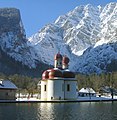










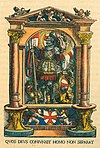

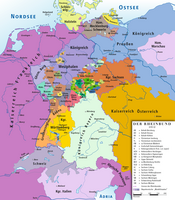
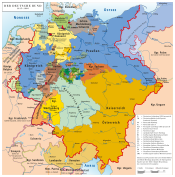
-en.png/175px-Deutsches_Reich_(1871-1918)-en.png)
